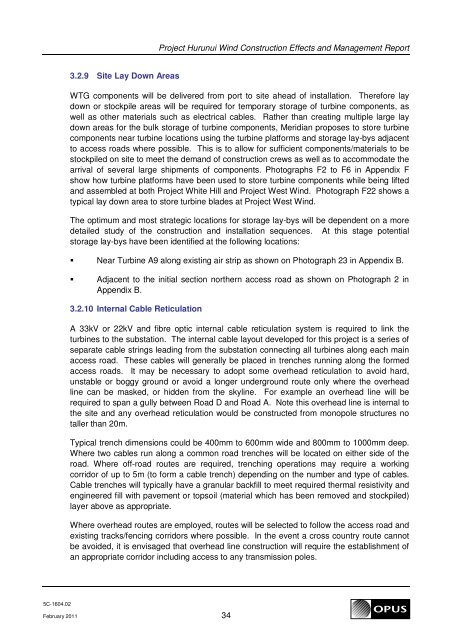Project Hurunui Wind Construction and Project Overview
Project Hurunui Wind Construction and Project Overview
Project Hurunui Wind Construction and Project Overview
You also want an ePaper? Increase the reach of your titles
YUMPU automatically turns print PDFs into web optimized ePapers that Google loves.
<strong>Project</strong> <strong>Hurunui</strong> <strong>Wind</strong> <strong>Construction</strong> Effects <strong>and</strong> Management Report<br />
3.2.9 Site Lay Down Areas<br />
WTG components will be delivered from port to site ahead of installation. Therefore lay<br />
down or stockpile areas will be required for temporary storage of turbine components, as<br />
well as other materials such as electrical cables. Rather than creating multiple large lay<br />
down areas for the bulk storage of turbine components, Meridian proposes to store turbine<br />
components near turbine locations using the turbine platforms <strong>and</strong> storage lay-bys adjacent<br />
to access roads where possible. This is to allow for sufficient components/materials to be<br />
stockpiled on site to meet the dem<strong>and</strong> of construction crews as well as to accommodate the<br />
arrival of several large shipments of components. Photographs F2 to F6 in Appendix F<br />
show how turbine platforms have been used to store turbine components while being lifted<br />
<strong>and</strong> assembled at both <strong>Project</strong> White Hill <strong>and</strong> <strong>Project</strong> West <strong>Wind</strong>. Photograph F22 shows a<br />
typical lay down area to store turbine blades at <strong>Project</strong> West <strong>Wind</strong>.<br />
The optimum <strong>and</strong> most strategic locations for storage lay-bys will be dependent on a more<br />
detailed study of the construction <strong>and</strong> installation sequences. At this stage potential<br />
storage lay-bys have been identified at the following locations:<br />
Near Turbine A9 along existing air strip as shown on Photograph 23 in Appendix B.<br />
<br />
Adjacent to the initial section northern access road as shown on Photograph 2 in<br />
Appendix B.<br />
3.2.10 Internal Cable Reticulation<br />
A 33kV or 22kV <strong>and</strong> fibre optic internal cable reticulation system is required to link the<br />
turbines to the substation. The internal cable layout developed for this project is a series of<br />
separate cable strings leading from the substation connecting all turbines along each main<br />
access road. These cables will generally be placed in trenches running along the formed<br />
access roads. It may be necessary to adopt some overhead reticulation to avoid hard,<br />
unstable or boggy ground or avoid a longer underground route only where the overhead<br />
line can be masked, or hidden from the skyline. For example an overhead line will be<br />
required to span a gully between Road D <strong>and</strong> Road A. Note this overhead line is internal to<br />
the site <strong>and</strong> any overhead reticulation would be constructed from monopole structures no<br />
taller than 20m.<br />
Typical trench dimensions could be 400mm to 600mm wide <strong>and</strong> 800mm to 1000mm deep.<br />
Where two cables run along a common road trenches will be located on either side of the<br />
road. Where off-road routes are required, trenching operations may require a working<br />
corridor of up to 5m (to form a cable trench) depending on the number <strong>and</strong> type of cables.<br />
Cable trenches will typically have a granular backfill to meet required thermal resistivity <strong>and</strong><br />
engineered fill with pavement or topsoil (material which has been removed <strong>and</strong> stockpiled)<br />
layer above as appropriate.<br />
Where overhead routes are employed, routes will be selected to follow the access road <strong>and</strong><br />
existing tracks/fencing corridors where possible. In the event a cross country route cannot<br />
be avoided, it is envisaged that overhead line construction will require the establishment of<br />
an appropriate corridor including access to any transmission poles.<br />
5C-1604.02<br />
February 2011 34
















